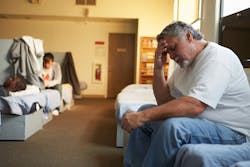Medical Respite Programs for Homeless Prove Their Value During Pandemic
Medical respite programs care for people experiencing homelessness who are not sick enough to stay in the hospital but are too sick to return to a shelter or the streets. When the pandemic struck, the 100 respite programs around the country played a critical role in supporting homeless individuals and hospitals experiencing a surge in capacity.
Pooja Bhalla, R.N., chief operating officer of the Illumination Foundation in Orange, Calif., said her organization has six recuperative care sites with 250 beds across Southern California. Much of the funding comes through a Medicaid 1115 waiver program called Whole Person Care in California. (That waiver is set to expire at the end of 2020.)
The Illumination Foundation gets referrals from hospitals that identify individuals with medical issues who can’t be on the street or in shelter but who need comprehensive services, she said.
When COVID hit, Illumination was called upon by the local public healthcare agency and the county board of supervisors to lead local efforts to operationalize “Project Roomkey,” which is the name of Gov. Newsom’s effort to assist the homeless during the pandemic. The state secured thousands of isolation rooms in hotels and motels for extremely vulnerable individuals experiencing homelessness to help flatten the curve and preserve hospital capacity.
“We quickly put this together a plan that involved six motel sites, two were for people who were COVID-positive, and the other four were for people who were homeless and vulnerable in shelters to reduce density," Bhalla said. She added that they had to overcome neighborhood opposition to opening a few of the sites. Overall, they had 780 contracted rooms and 1,570 clients served, 205 of whom were COVID-positive.
“We went to nine shelters in three days to bring individuals into these settings,” she recalled. “One day, we took in 45 individuals from one shelter because they had 12 positive cases.”
Illumination had to deal with a whole new range of issues, including creating a 24-hour intake process, dealing with staff safety and personal protective equipment inventory, a COVID testing protocol, and daily communications with public health, shelters, homeless outreach street teams, she said.
Ninety-one percent of the population came from either the streets or shelter. The Project Roomkey program is set to end on Sept. 30, and people are concerned about where they are going to be discharged to, she said.
Bhalla was speaking during a recent webinar, coordinated by the Center for Health Care Strategies (CHCS) and the National Institute for Medical Respite Care (NIMRC), which was launched in July to identify best practices, offer expert services, and advance state-of-the-field knowledge in medical respite care. Research has shown that those who participate in medical respite programs are 50 percent less likely to be readmitted to a hospital at three months and 12 months post-hospital discharge, which ultimately generates significant savings for hospitals and communities.
Also speaking on the panel was Sara Jeevanjee, M.D., medical director of the Santa Clara Medical Respite Program in San Jose, Calif. Her respite program has 30 beds and is located on-site at a shelter. Referrals come mostly from nine county hospitals.
The program played a key role in the county’s efforts to cope with COVID-19, she said.
“I think the idea was to both reduce the risk of exposure for the medically vulnerable and expand our capacity so we could offload patients from hospitals,” she said. “We wanted to help hospitals maintain their capacity.”
The respite patients were relocated to motels two days after the shelter-in-place order went in effect. This required changing many to protocols, including expanding mobile medical unit operations and creating new telehealth teams to serve patients in motels. Other new practices include daily temperature and symptom screening, collaborating with partners for admissions and exits and providing psychiatry via telehealth.
Among the lessons learned, Jeevanjee said, is that community partnerships are more essential than ever, and the respite program is part of a much broader county response.
Also, single private rooms work well for some individuals, but not for others. “The same gaps in care exist as pre-COVID. “We need more supportive environment for those with cognitive impairment, the physically frail, incontinent, and those with severe mental illness. “Those gaps still exist. We had people placed in motels who could not care for themselves. Also, telehealth has been touted as a new model of care delivery. It is great for many people, but it is challenging for our population.”
Finally, Leslie Enzian, M.D., medical director of the Edward Thomas House Medical Respite in Seattle, said her respite center helped other organizations by training staff for isolation and quarantine sites on harm reduction and trauma-informed care practices. It also shared staff with newly opened COVID shelters and shared referral and admissions process, policies and procedures. It also shared UW Medicine protocols and respite practices with county programs and other respite programs preparing for COVID.
When the NIMRC was announced in July, it issued a statement from Bobby Watts, CEO of the National Health Care for the Homeless Council, which launched the NIMRC as a special initiative: “The past several months have magnified the need for medical respite care. COVID-19 brought new attention to the fact that patients experiencing homelessness need access to medical and mental health services and supportive services in a safe, therapeutic setting. Medical respite care fits the bill,” he said. “There is no doubt medical respite care improves the lives of individuals, families, and communities. Through NIMRC, we will work with our partners, consumers, and others to make medical respite care a more readily available part of the solution to ending homelessness.”


